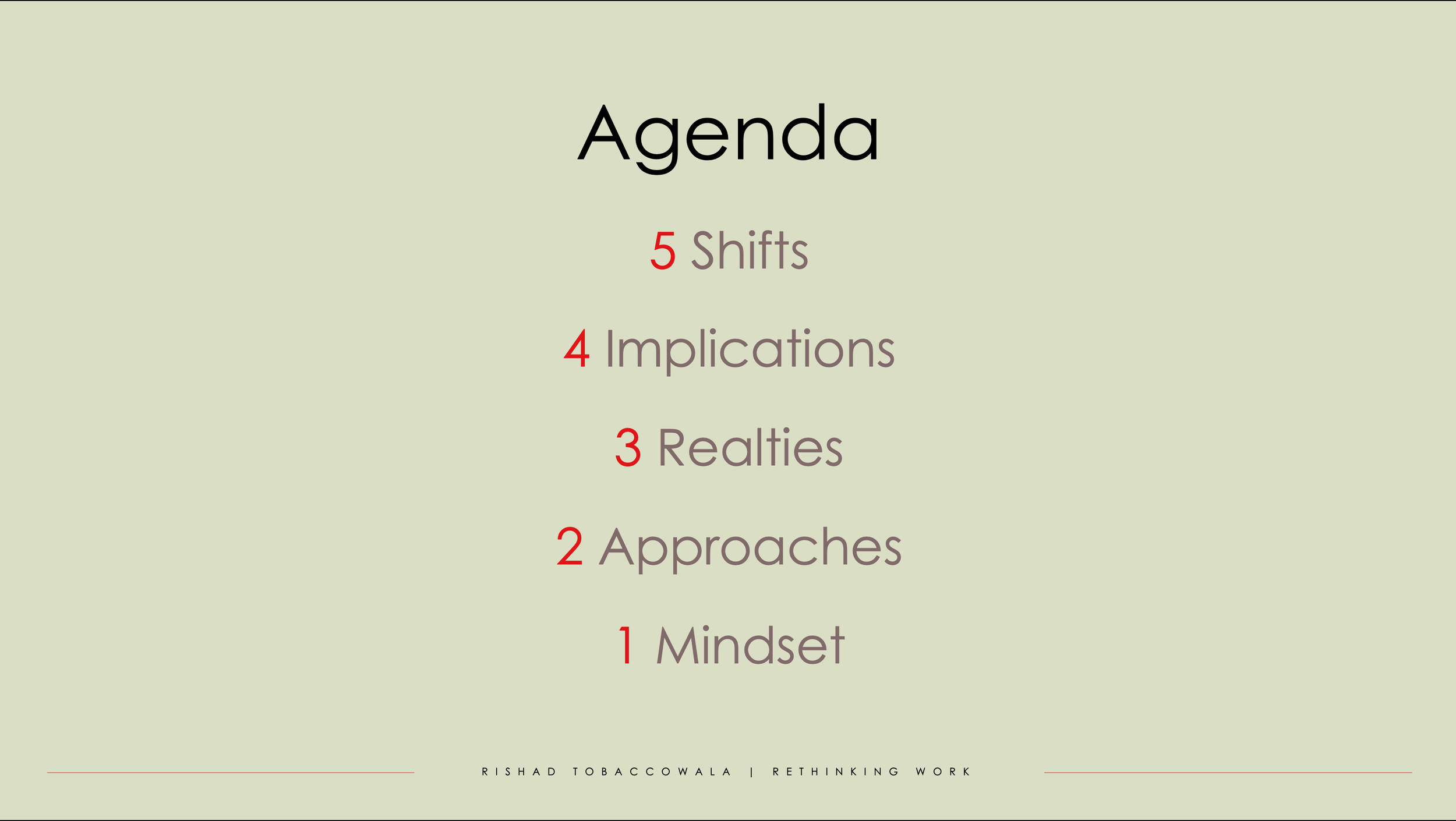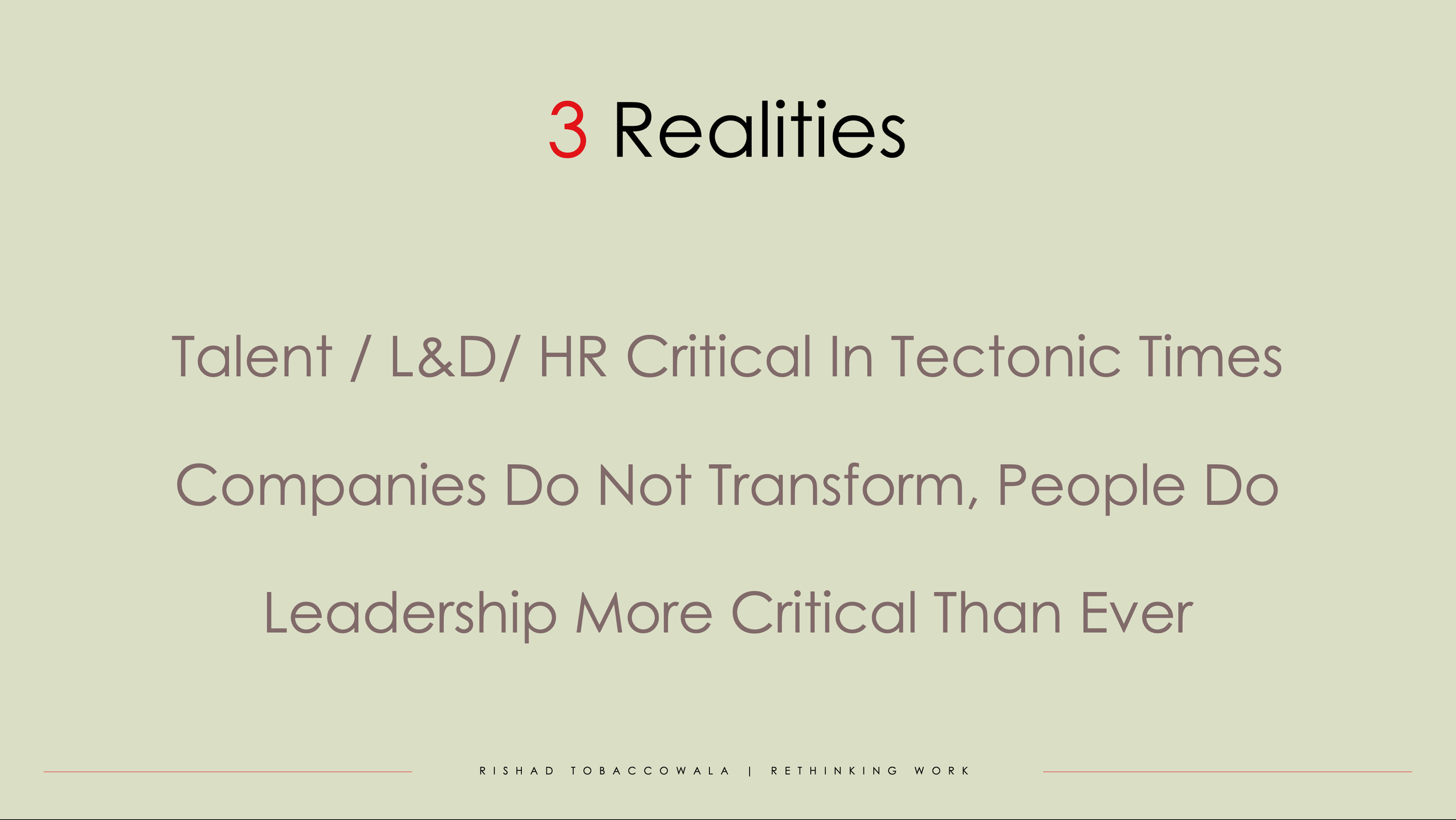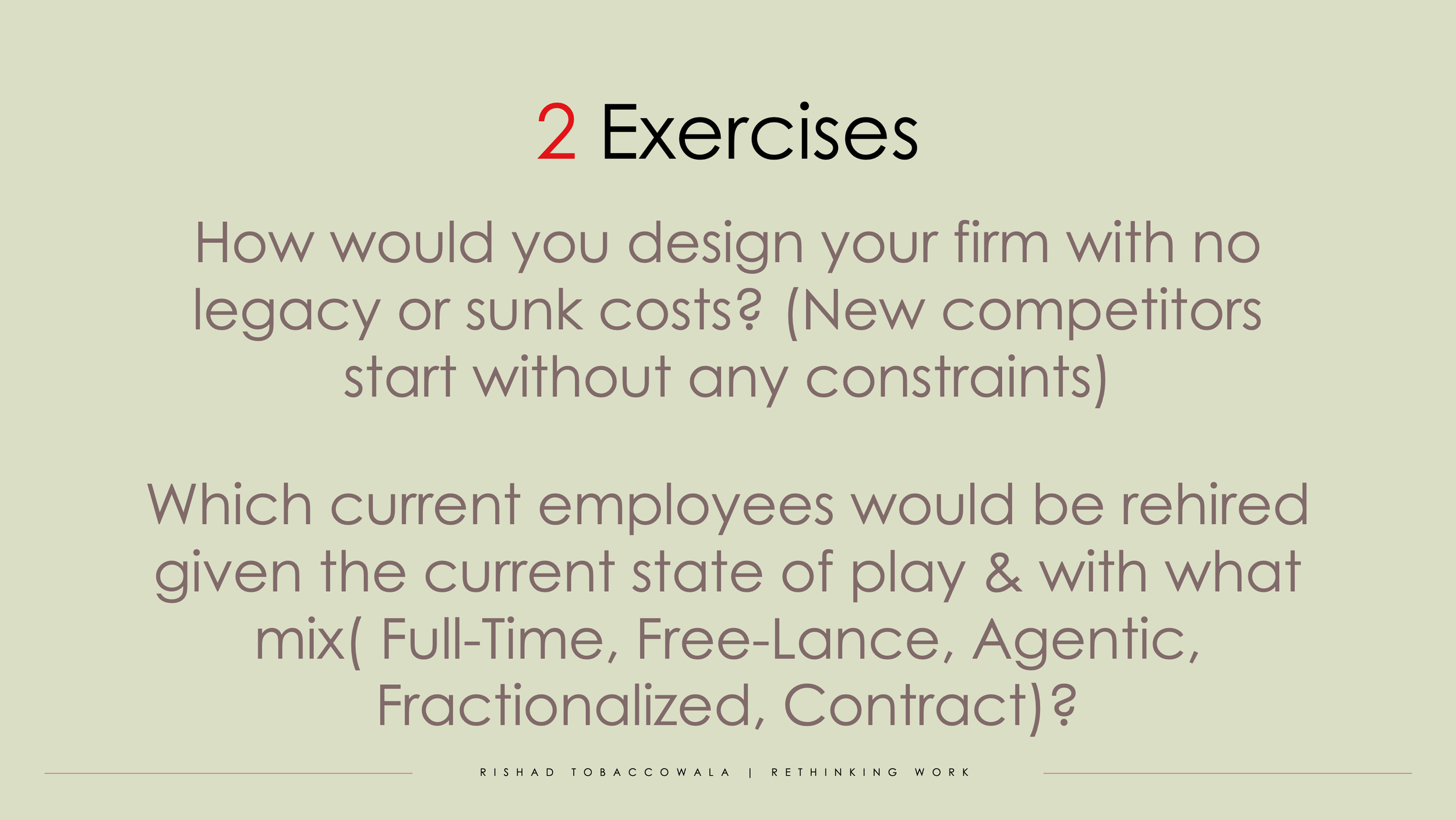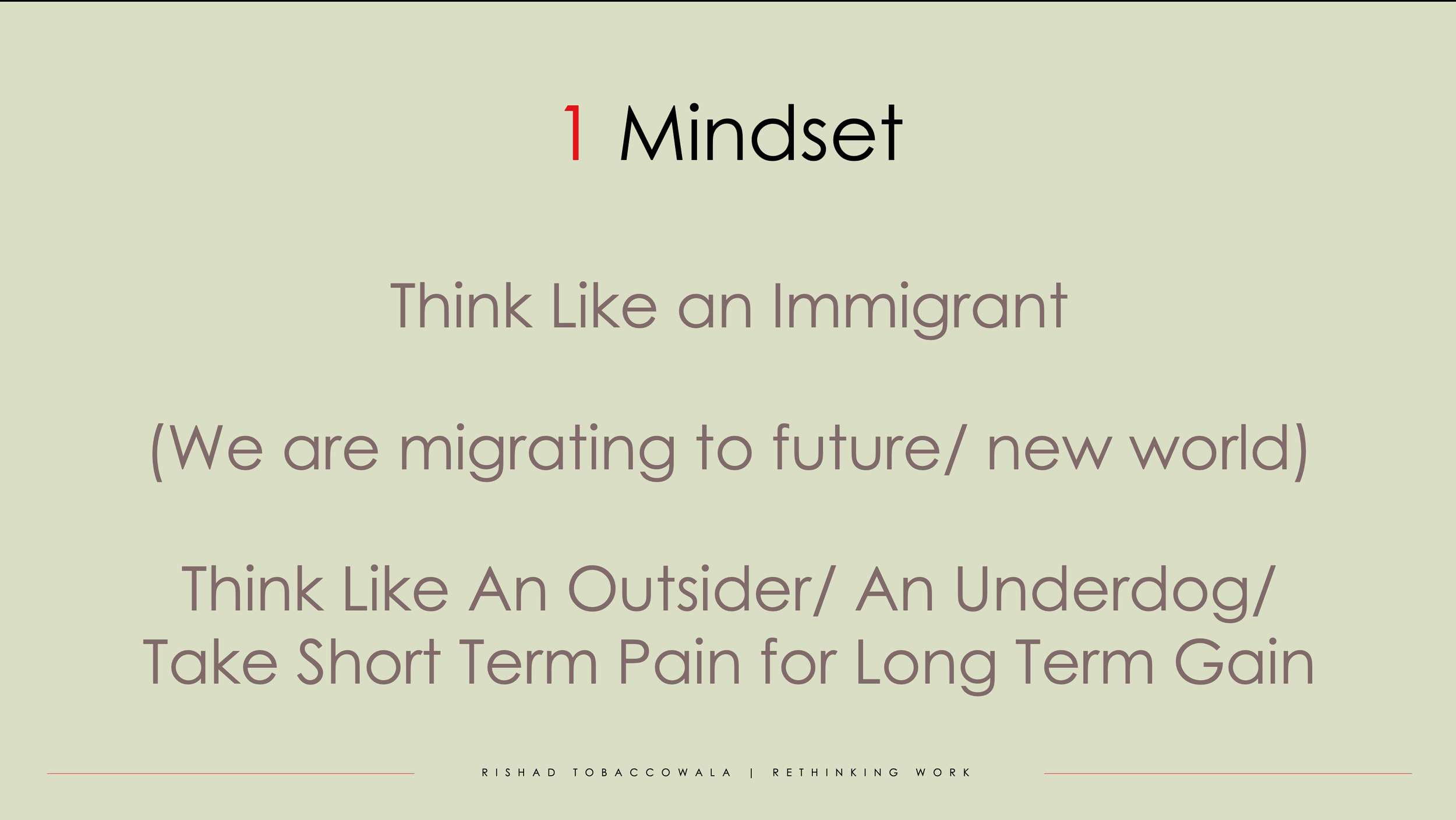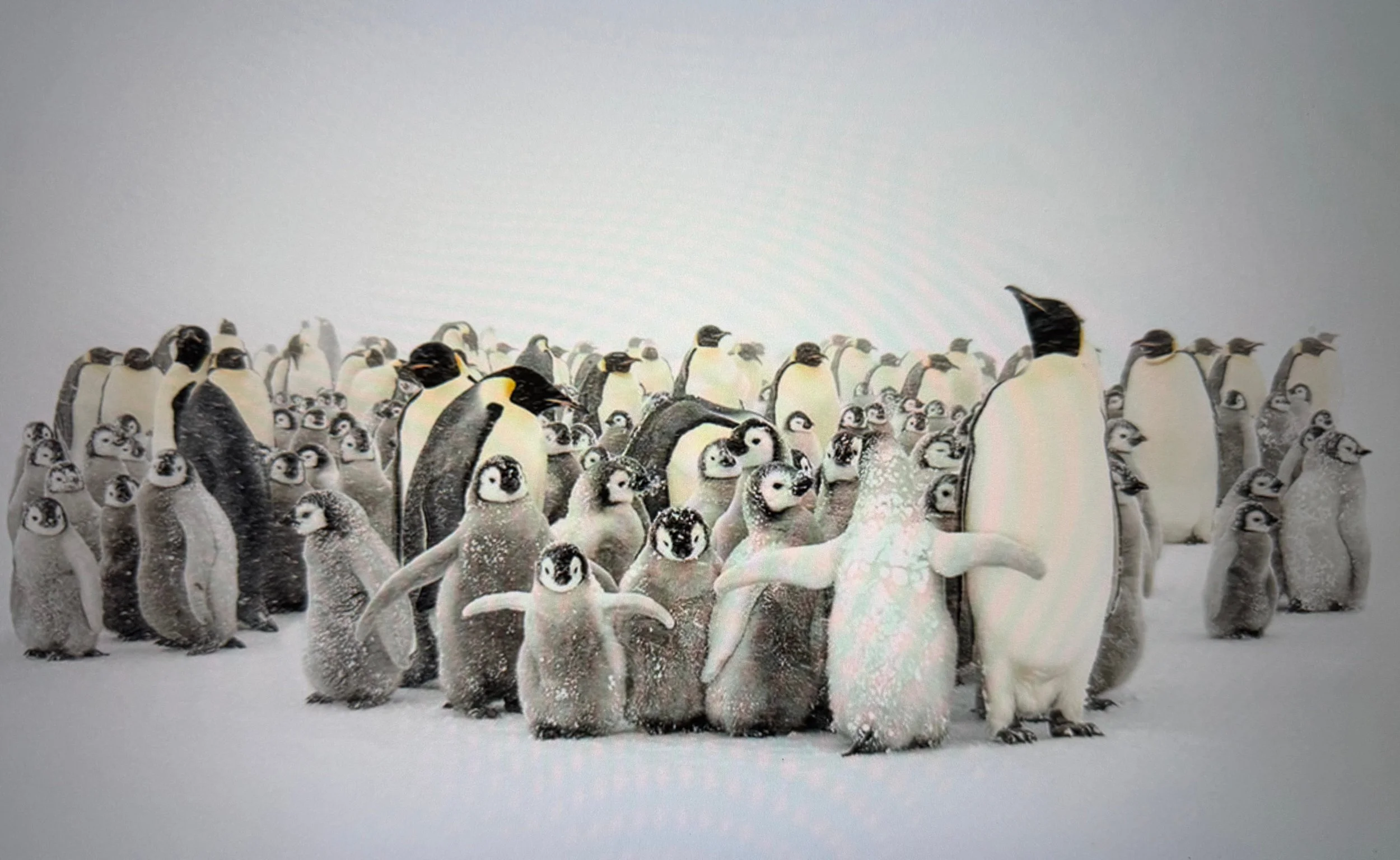Rethinking …
The most popular edition of the 268 posts of this Substack so far is Rethinking Presentations on how to put together powerful presentations with only 9 slides!
The third most popular post is A Company of One on a way to ensure one remains relevant in a world of changing work.
This post combines a second approach to rethinking presentations and then illustrates how the format is used to get people to start rethinking work.
Rethinking Presentations 2
Rethinking Presentations 1 showed how to put together a presentation to make a sale or get an order and remains a very impactful way to do so.
Over the past few years as I have worked for myself rather than a company. I spend less time selling and more time advising, explaining the tectonic shifts we are experiencing and trying to inspire new behavior. Here is a very simple approach anyone can use when one is trying to educate, explain or inspire change.
The three key outcomes this new format seeks to deliver are:
a) Accessible explanations that are simple, focused and identify all the key issues. People are overwhelmed.
b) Actionable inspiration that leaves people not just feeling inspired but armed with a way to take action right away.
c) Personalized relevance in that every single person finds relevance to their personal situation. It must resonate to help them solve a problem or take advantage of an opportunity.
This approach also requires only 9 key slides:
Slide 1: Title Slide (Action oriented)
Slide 2: Agenda (A simple, impactful way to telegraph what is to follow)
Slide 3: Shifts (What are the forces driving the changing situation and future)
Slide 4: Implications (What are the implications of these key shifts on the audience)
Slide 5: Realities (The hard truths and key challenges we need to face)
Slide 6: Approaches (What steps should one take right now)
Slide 7: Mindset (How to frame and address the situation moving forward)
Slide 8: Questions (Interaction and Q&A key when trying to explain/inspire)
Slide 9: Resources (Ways people can learn more and upgrade themselves)
Rethinking Work
The Rethinking Work presentation below uses this 9 slide approach to explain to management why work will change more this decade than the previous 50 years and what leaders and companies need to understand and address right now.
But this same approach can be used by anybody who wants to educate, explain and inspire on any subject or topic. It is totally modular. Just change topic and put in the relevant shifts, implications, realities, exercises and mindsets!
Five interconnected shifts will change work more this decade than the past 50 years.
Demographics of declining & aging population. Different mindsets across generations.
Technology (AI, Blockchain & Media Landscape where everyone is a media company).
Marketplaces that allow individuals and companies to access talent and opportunities.
More people will work part time or free-lance than full-time in the USA starting 2026.
Covid did not just change where we work but why we work and who we work for.
Four implications that organizations and leaders must address.
More and more work will be done without filling jobs. Until 200 years ago there was lots of work and few jobs. We are now going to have more and more work and income/wealth opportunities than ever but fewer jobs. We are past peak jobs.
Full-time, freelance & contract employees will be joined by fractionalized employees and agentic workers.
Current structures of most companies are often built around jobs rather than how to get work done by attracting and retaining the best talent with the greatest agility and affordability.
Debossification is the only way forward where leaders focus on zones of influence vs zones of control. Where leaders spend the majority of their time selling, building, inspiring, servicing and mentoring vs. monitoring, measuring, processing, and checking in, all of which will be done better by AI.
Three realities every company must face.
Companies do not transform people do. Change never happens without a talent plan.
Talent/L&D more critical than ever but must reinvent themselves and be less fearful.
Leadership is the critical element more than technology or strategy or partnerships.
Two Exercises.
Most management is world class but often self oppress and limit themselves by imagining constraints that only exist in their minds. These two exercises suggest starting with a fresh sheet on both the organizational and talent front.
Why is the current organizational structure which was probably out of date pre-Covid, pre-AI, pre-distributed work, still relevant for the tectonic changes coming? Without the right spinal architecture it makes no difference what AI or other organs are added.
The only thing a company has is talent. If the game changes and the playing field changes, talent needs to be rethought via a combination of upgrading skills, new ways of working and accessing of enhanced expertise both inside and outside the firm.
One Mindset.
We are all migrating to a new country, a new world, an unknown zone called the future which will not look like the place we are today.
So why have an immigrant mindset?
We need to think like outsiders since the new risks and opportunities will come from outside our existing competitive set.
We need to think like underdogs since AI is the slingshot that allows David to bring down Goliath. Moats might be used as sources of water to flood our castle!
We need to take the hard painful decisions and make the sacrifices now so we and our company can thrive in the future.
Questions and Resources to Keep Learning.
Education, Learning and Reinventing are constant.
Here are three completely free resources to upgrade one’s mental operating system:
This Substack (The Future Does Not Fit in the Containers of the Past)
A weekly podcast (What Next?) where every week people who are forging the future share their best insights, provocations, perspectives and points of view.
And The Rethinking Work Show a show on YouTube but also on Spotify and Apple where every week a discussion with people reinventing work from CEO’s and architects wrestling with back to the office, technologists introducing agentic employees into the work place, academics with data that put a lie to so much fuzzy thinking about the future of work, pioneers designing new firms which are AI first, different generations speaking about companies and work and much more…
You can download the extended (18 slide version of this presentation which goes deeper into the 5 shifts and the 4 implications) here by clicking on the presentation and you may use it in anyway you want.
Also at Rethinking Work check out the resources section where there is career advice and lots of stuff to help every one become better and more effective. If you or someone you know is rethinking your career these four articles might completely change the way you plan the rest of your working life.
On Leadership and Culture.
Companies and organizations that thrive excel in two areas:
Leadership and Culture.
They are both key and closely intertwined.
A. Leadership.
Leadership can be distilled down to this:
Leaders acknowledge, face and communicate reality.
People follow people and not titles since titles are bestowed while leadership is earned.
The six characteristics of great leaders are capability, integrity, empathy, vulnerability, courage and inspiration.
Reality.
A key to leadership is to solve challenges and address problems. This requires confronting issues versus looking away or hoping some form of magical thinking will make them go away.
People will follow a person if they suspect they are not addressing real issues and challenges however difficult they may be.
Followership.
Without the hearts and minds of the team one is not a leader but a ruler.
Rulers leverage fear, project power and exploit insecurity.
Employees genuflect, fall in line, salute and pander to the hollow and bloated boss, while they silently seethe, plot insurrection or practice defection.
Six Characteristics.
a) Capability: To be a leader one must be capable in one’s field of work or craft and to keep improving and honing one’s skill with a dedication to a growth mindset. Doctors will not listen to doctors who are not great at medicine. A creative will not respect someone whose body of work they do not admire.
b) Integrity: Can one be trusted? Does what one says, what one does and how one behaves aligned and also resonate with the rules of science and economics ?
c) Empathy: Leaders can see from other points of view and they understand that employees are people and work is a very important part but all of their being. They understand and they listen. They care. They do this both for employees and for customers.
d) Vulnerability: Great leaders acknowledge mistakes. They know they do not have all the answers. This means they are open to criticism and correction and they surround themselves with skills sets that offset and balance their areas of weakness.
e) Inspiration: How do leaders face and acknowledge reality and hard truth but still get people to unite, align and take the challenges head on? They do so by recognizing that people choose with their hearts and not their minds. They inspire through a combination of personal example and storytelling.
f) Courage: The courage to make the hard decisions. The courage to take calculated risks. To understand that sticking to principles often comes with a price.
B. Culture
It has been said that “culture eats strategy for breakfast’ and often when companies decay ( Sears) or resurrect (Microsoft) or have distinctly different outcomes in the same industry (Delta vs American) a key determinant is the culture. What it is like, how it is improving or how it is getting worse.
Next Wednesday on The Rethinking Work Show we will hear from Alastair Creamer and Doug Milliken who co-founded Creamer and Milliken which help some of the best companies in the world on cultural change.
Once I read that the culture of an organization is revealed in how people behave when no one is looking or monitoring their behavior.
It is not just heard or seen but felt as my guests so eloquently stated.
Culture is about people. Yes, it requires leaders to set, correct and support the culture but it is how they treat people and how people feel about themselves, their company and their colleagues that is the fabric of culture.
Companies with great cultures tend to have talent who feel most of the following about their jobs and companies:
Excellence: One cannot have a great culture without excellent financial results, products/services and superior talent. People. Product. Profit. At least two of these need to be firing on all cylinders most times. Companies sometimes reduce the emphasis on one to invest in one of the other areas such as reducing profit to invest in new products.
Good Compensation and Aligned Incentives: If people are not paid adequately or fairly it really hard to attract and retain the best people to have a good culture. Companies do not need to have the highest compensation but they need to ensure the gap between them and their competitors is managed. But it is not just individual compensation but ensuring that incentives are aligned with the behavior that is expected. If team work is key there should be a greater focus on rewarding team results versus individual results ( though both are important)
Recognition : Great cultures recognize contributors and key players ( “difference makers”). They ensure people are heard.
Autonomy: People are trusted to deliver with limited monitoring and can access resources to do so. Freedom within a framework versus rule books and overly regimented “play books”.
Purpose: Talent believes in the purpose and values of the company and see the role of their company beyond that of just profit but ensuring their customers thrive and giving back to society or community.
Growth: The company is growing, has a plan for growth or even if static, the individual is growing and teams are growing by being given opportunities to learn and build new skills.
Connectedness: People feel connected to each other and to their leadership. They feel free to speak up and share and even joke. They express themselves without fear.
Solving for and focusing on these seven drivers of culture is one way smart leaders are working to ensure that in a distributed world with different types of employees including AI agents the fabric of culture is not torn.
They and their talent/people leaders will all have different approaches to get there but they all recognize it is key to ensure that each of these seven seeds of culture are watered.
Leadership and Culture and not technology or strategy or size that are they keys.
Photos by Roger Fishman.
Fear…
Image by Midjourney to the prompt "fear"
If there is one emotion that is increasingly widespread across the world it is that of fear.
It is particularly acute in the world of business at every level and in every industry.
Fear beats like a second heart beneath an outward veneer of confidence.
What we fear at work is multi-faceted and multi-modal. Here are just a few factors:
a) Will our jobs be automated away by AI ? A very senior person who I respect in the world of tech wondered if the new tech they are creating is the wood chipper that they will be fed into? Are they architecting their own obsolescence? In other industries all of us wonder if AI will create a hunger games environment inside each company as they launch efficiency drives forcing us to compete for fewer and fewer opportunities.
b) Are we still relevant as leaders? As younger generations look with great dubiousness at their seniors, wondering what they do and the price they paid to get their roles, the senior folks also are grappling with change coming so fast that they no longer have the option to wait it out. With many financial obligations, the increasing insecurity of of one’s job and need to reinvent oneself make us fearful.
c) Where are the opportunities to grow? The great flattening is removing many middle management opportunities and roles while a combination of AI and uncertainty is making companies delay hiring even if they are growing. Companies worry both about business softness but also suddenly finding themselves with too many people if the new technology truly increases productivity.
d) Can we say anything that does not get us into trouble? Despite all the statements about fearless environments, risk-taking, the freedom and growth that comes from the clash of ideas, and the emphasis on experimentation happy talk, there is a dark cloud lurking. One of sinister monitoring and pressure to align, conform, and comply that invisibly defangs attitude , depersonalizes individuality , devalues provocation and dismisses those who walk another path.
e) Do we have a pretend job? Alex McCann who I will have as guest on The Rethinking Work show next week has an amazing series called “The Death of the Corporate Job” that begins like this:
Last week, I had coffee with someone who works at a big consulting firm. She spent twenty minutes explaining her role to me. Not because it was complex, but because she was trying to convince herself it existed. "I facilitate stakeholder alignment across cross-functional workstreams," she said. Then laughed. "I genuinely don't know what that means anymore."
She's not alone. I keep meeting people who describe their jobs using words they'd never use in normal conversation. They attend meetings about meetings. They create PowerPoints that no one reads, which get shared in emails no one opens, which generate tasks that don't need doing.
The strangest part: everyone knows. When you get people alone, after work, maybe after they've had time to decompress, they'll admit it. Their job is basically elaborate performance art. They're professional email forwards. They're human middleware between systems that could probably talk directly to each other.
f) We fear the death of leadership: So many “leaders” seem to have weather vane minds and squishy spines that are quick to align. Fleshy things who have a tropism that bends towards money and power. They tremble like leaves shivering with fear, rootless without any principles, but put on the show of florid orchids.
Fear leads many of us to go through the motions. We need the job. So we repeat the new mantra. Espouse the updated values. Chant the company slogan. We go along and get along. Hail the new leader! Hail the visionary Board! Hail the re-organization! Hail yet another re-organization!
Some keep their heads low and save all their passions for the side job. Others filled with hot air conflate title and the power that comes with the title as ones own power though deep down they know differently.
Overcoming Fear
We should not give into fear.
Because when we do, we lose everything including our ability to think for ourselves.
Frank Herbert wrote in Dune: "Fear is the mind-killer."
And when we are ruled by fear we are defeating ourselves.
We are practicing self-oppression.
Ralph Waldo Emerson wrote : “Fear defeats more people than any other one thing in the world."
Fear is natural but it is also the fuel that often can ignite courage.
"Fear is a reaction. Courage is a decision." — Unknown
"Courage is not the absence of fear, but the triumph over it." — Nelson Mandela
If we are fearful of someone we should know this:
The fearsome are often fear filled: An outward shows of great confidence is often co-related with deep anxiety. The folks who are the most arrogant, the most sure of themselves, the least approachable are usually the most insecure. Other wise why all the drama?
First comes confidence. Then comes humility.
Many of the really accomplished people are gracious, generous, and kind. They know they are good. And that is enough.
And so the first way of overcoming fear of others is by recognizing that usually the ones who fill one with fear are usually fretful themselves.
Do not fear them. Instead take pity. Do not tremble. Put out a hand in friendship. They are not bad people but just isolated and worried with many challenges and difficulties of their own.
Stay true to an internal compass: The thing to fear is not others but when one we let ourselves down. When we lose our internal sense of bearing and the trueness of things. The point about principles is often one has to pay a price to stay true to them.
If we are fearful of being replaced or becoming obsolete we should do this:
Upgrade our skills: It is easier than it looks and often does not take much money. Today there is a world of online and offline capabilities ( including people in our organization willing to help us). All we need to do is to allocate an hour a day to learn new things. Very soon we will realize that the new technologies are not that difficult. When we invest $60 to get the paid version of Open AI, Gemini and Claude we have better AI than the company we work for will ever have since they sandbox the most recent version and tend to scale on just one foundational model.
Maximize our Optionality: When we lack choice we feel cornered. Everyone should put a plan of action to enable options right away even if it takes a year or two or three to manifest itself. Build a reputation. Launch a side hustle. Feed a network. Reduce spend. Save a little nest egg. The more options we have the less we can be controlled by anyone or any firm and the less we are fearful. Too many people start looking for the next opportunity when the current gig becomes untenable. Do it now. Sooner or later, through choice or circumstances we all need to leave. Every career has a midnight hour and the smart people leave at five to twelve. The more options one has the longer one can stay in a difficult role and the less likely we will fear other people.
Fear is natural. It is a signal that we are alive. But it is also the catalyst to courage, the driver of decisions, the igniter of revolutions.
We have nothing to lose but our fear.
Soul. Human. My first book is even more relevant today as recent circumstances have people recognize we truly need to restore the soul of business and remain human in an age of AI…learn more here…https://rishadtobaccowala.com/restoring-the-soul-of-business
Strategic Reset.
Strategy is “future competitive advantage”.
What will the people we sell to need in the future?
Who will we be competing with in the future?
Given these people needs and competitors what advantage will we provide?
A case can be made that every organization and every individual who has not updated their strategy in the past three years must do so with urgency because we are seeing the contours of the future shift dramatically.
1. People expect more.
It is clear that people in addition to wanting things better, faster and cheaper as they have always done, are now placing a premium on solutions, expect accessibility of everything, everywhere, every time and in every form, values ( companies and people that align with their passions and leanings) and experience ( service, impact, memorability).
Its not just BCF ( Better Cheaper Faster) but now also SAVE (Solutions, Accessibility, Value and Experience)
2. Old assumptions are less true.
Many of the assumptions that underpinned strategy have not only shifted but, in some ways, the exact opposite of what firms believed is coming true.
Here are just a few “beliefs” that now need to be queried:
a) Expanding populations: When calculating “Total addressable market” or “rate of growth” most companies factored in growing populations.
Now the exact reverse is beginning to happen. Populations have started to decline in most advanced economies at a frightening rate. Outside of 7 countries in the world, population is either flat or in decline. This year the US may have its first decline in population. It takes 2.1 children per woman to keep the population the same and the number today is 1.6 in the US with the rest being made up by immigration which is now going in to reverse. In 2025 there will be 2. 5 million fewer immigrants coming into the country versus year ago. If immigration remains curtailed population will decline by tens of millions in the next two decades. To see the future look at China ( 1.1 children per woman) or Korea ( .8 children per woman) where there is excess housing, closing down of schools and replacement of toy stores with pet stores. GDP growth is often co-related with population growth.
b) Scale is a competitive advantage: While scale still matters it matters far less than ever before (except for a few businesses like funders of Large Language Models, Data Centers, Chip Manufacturing, Pharmaceuticals and a few others where it matters even more).
The very nature of what is scale is changing with many old forms of scale being competitive disadvantages!
Scale of Distribution: With direct to consumer marketing enabled by the Internet and platforms like Shopify, widespread retail distribution is no longer as effective an advantage outside of a handful of companies like Walmart.
Scale of Communication: New media behaviors by people particularly search and social are leading to communication channels where spending power is less aa competitive edge as it was in television or print where marketers cornered key inventory at advantageous prices. Now as we enter an Answer vs a Search economy we can anticipate greater shifts.
Scale of Manufacturing: The “Everything as a service” platforms from Amazon Web Services to Foxconn allow smaller companies to gain the edges of scaled manufacturing, distribution and technology without any of the legacy disadvantages of size.
Scale of People: From IBM to Unilever to GM who have hundreds of thousands of employees and therefore have the ability to recruit and grow a range of talent and offer career advancement. Scale of people continue to be important to execute complex and large tasks but there are also new ways to re-aggregate talent. And a generation of talent wants to work in smaller and more entrepreneurial environments. The new metric is revenue per employee versus number of employees.
Today AI further reduces most of these advantages with AI accessible at $20 to $200 a month providing small firms (David) with access to knowledge, expertise, production and much more as a slingshot to compete with large firms (Goliath)
In addition to the diminishment of legacy scale which allows for new entrants, there is also a rise of new types of scale that are becoming increasingly important.
Scale of Data: Increasingly companies are realizing that collecting, refining and leveraging data is what is driving the modern fast growing and highly valued companies from Amazon to Google to Uber.
Scale of Networks: On the Internet network effects play a dominant role in creating winners. Dominant platforms such as Google, Meta, Netflix, TikTok enjoy flywheel effects of more users attracting more users and therefore marketers and businesses.
Scale of Influence: Today individuals have tens of millions of TikTok followers or leverage X to reach hundreds of millions of people with single post and tweet. Podcasts and Substack are allowing talent to unhook themselves from companies. If you look at scaled entities on social media, they are individuals and not companies.
Scale of Talent and Ideas: One of the lessons of history is that every advance in technology places a premium on superior talent. Technology is a lever and great talent can have major scale effects. AI is the ultimate lever for talent.
c) Work and Jobs are the same thing: The rise of marketplaces from Fiveer to Upwork, from Shopify to Etsy, from Uber to Amazon have allowed individuals to access opportunities and offer services and products in a scaled global way from their mobile devices. Add the acceleration of work from anywhere made possible by distributed work and now the removal of barriers to knowledge or talent (agents, free-lance, fractionalized employees) and the biggest shift which almost no company is prepared for is underway. 67 percent of Gen Z with a full time job have a side hustle or side gig with which they make money and whether they are forced back to the office or not they are preparing for next. In fact forced mandates to return to the office is increasing their urgency and reason to seize their future with the best talent who have the most options being the first to peel off.
Work can be done without filling a job.
Work and jobs are uncoupled.
Most companies are organized around jobs vs work. Most companies believe most of the work is done by full time employees at places they go to versus most of the work is done outside the organizations by a combination of different talent and agents they access.
Implications for Companies.
a) Some of greatest opportunities and threats come from outside ones category when consumer, technological and nature of work change: Uber and Tesla came from outside the automobile industry. The big winners of the next generation will be companies we have never heard of. Today Morgan Stanley is challenged by Robinhood, Adobe by Figma, many companies by Open AI. If strategy is future competitive advantage it is critical to look outside ones current competitive set.
b) Run Schizophrenic Models: If one looks at the next generation of challengers one will find many of these companies to be a) AI first, b) Talent anywhere, c) Plug and Play, d) Ultra fast.
It will be very difficult to take a company that is very successful today to reinvent itself fast enough by trying to make the changes within. Instead a company should take a significant portion of its best talent, provide them with access to all the resources of the company and ask them to create the next version of the company. This way the new unit while connected to the mother ship is not burdened by existing Client demands, processes, business models and ways of making money. And the existing business focuses and optimizes the current business model to maximize cash flow and minimize distraction to help fund tomorrow. The existing business not only learns the new methods, retains talent that may want to go to start-ups or new opportunities but also then begins to assimilate the best of the new innovations and bring back the talent they exported as they scale
Implications for Talent.
a) Prepare for a completely different landscape by 2027 : Knowledge will matter less as it can be accessed on demand for $20 a month. Experience gets less important as the ability to unlearn and learn becomes key.. Almost everything that one does that can be done better by AI will be, and if one cannot build new skills to work alongside AI one’s career regardless of level will be at risk. The possibility that a full time job will be replaced by a main job that provides cash flow and insurance ( fractionalized employee) plus a number of other gigs will be the dominant form of earning an income however scary and improbable it sounds.
b) Seize the future of your career with urgency and do not delegate it to others: Carrie Underwood asked Jesus to take the wheel but when it comes to a strategy for one’s livelihood and future we need to take the wheel. Please remember that HR works for the company that you work for and does not work for you.
Hone skills. Build a reputation. Plug into networks. Launch the side gig. Up skill. Now.
Learn to become A Company of One ( A series read by hundreds of thousands that prepares one step by step to be one’s own future navigator). By learning to operate as a company of one allows us to have a long career in a company of tens of thousands. Not doing so will make us a company of one even if we do not want to be one or are not prepared.
Learn how people are forging and preparing for the future of work via the Rethinking Work Show.
On Wisdom.
Joy.
A definition of success is the freedom to spend time in ways that gives one joy.
Joy is more than happiness which is often transitory as it ebbs and flows with external events.
Joy is more akin to contentment and satisfaction.
Some believe it is momentary suggesting we have “flashes of joy”.
The joy that comes with deep satisfaction and contentment however endures and its contours do not waver with the oscillations of the transient.
Experience, time, and observation reveals there are ways to architect joy.
Joy=Grace+Flow+Connection.
Joy encompasses grace, flow, and connection.
The joyous exhibit graciousness, they tend to be in a state of flow and connected to both reality, other people, and some things higher and deeper.
Graciousness combines respect for others, a sense of humility and a spirit of generosity.
Flow comes from learning, making and building.
Connection is some combination of a greater purpose, spirituality and relationships with others.
To be free to use your time to pay attention to what matters and what matters to you.
Or as the late David Foster Wallace said in his mind shifting talk This is Water:
“The important kind of freedom involves attention and awareness and discipline and being able truly to care about other people and to sacrifice for them over and over in myriad petty, unsexy ways every day. That is real freedom. That is being educated and understanding how to think. The alternative is unconsciousness, the default setting, the rat race, the constant gnawing sense of having had, and lost, some infinite thing.”
Appreciation.
Among the teachings of the Stoics is the ephemeral nature of life and the passing of time.
The followers of Wabi-Sabi in the Orient recognize the impermanence, imperfection, and incompleteness of all things.
The Poet Kate Ryan writes of the “joy of finding lost things”
And Carly Simon in “Anticipation” sings that she will stay right here because these are the good old days.
From all these individuals one learns three mental exercises to appreciate what we have:
1.Imagine a thing you own or a person or place you appreciate lost.
All of us have lost things and sometimes re-found them.
A set of keys, a wallet, a passport.
Other times it is our health or a home or a job.
As the line goes “we do not know what we have until we have lost it”
2.Imagine that you were doing something for the last time.
What makes the ordinary and every day extra-ordinary is that one day it will not be so.
There will be a last day a child will crawl. A last day you will see someone. A last day you will visit a place or drive a car or go to a restaurant. Sometimes we know the last times and often we do not. When we are aware of the last times, we have a higher sense of attention and a sensitivity to the specialness and the passing of the moment.
But these last times come every week and sometimes every day.
The ordinary becomes extra-ordinary when we pay attention, and we find poetry in the crevices of every day
3.Imagine that the life you lead is the life that millions aspire to as you aspire to some other life.
Most humans aspire to the next better and bigger thing. A combination of our hedonistic adaptation (getting used to what we have), benchmarking against others and other things (the income and home we thought would be amazing a decade ago may be seen as just okay when compared to others) and imagination (our ability to imagine greater, bigger and better or be reminded of it in our media streams) all drive us to next.
We sometimes define our happiness by our advancement toward the things we do not have versus the things we do have.
Most people living in the Western World or Upper and Upper Middle Classes of most countries who also have their health are living the life that billions aspire to.
The life we have got used to is the aspiration for most people.
We may wish to celebrate every new day as a day of thanks and gratitude.
Loss
If there are three realities to life they are learning, love and loss. Not everybody succeeds at learning or love, but everybody gets a graduate degree in loss and a doctorate when people very close die.
Joan Didion wrote two books on the loss of her husband “The Year of Magical Thinking” and her daughter “Blue Nights” which are read by many dealing with loss.
She wrote of the fragility of life noting that her husband died while eating dinner: “Life changes fast. Life changes in the instant. You sit down to dinner and life as you know it ends” and the loneliness afterwards: “A single person is missing for you, and the whole world is empty.”
And as time moves forward and people, places and hopes come and go people are shaped by what is no more.
“We are imperfect mortal beings, aware of that mortality even as we push it away, failed by our very complication, so wired that when we mourn our losses we also mourn, for better or for worse, ourselves. As we were. As we are no longer. As we will one day is not at all”
But in the end Didion notes we go on by forging new stories and finding new places and begin forgetting.
“We forget all too soon the things we thought we could never forget. We forget the loves and the betrayals alike, forget what we whispered and what we screamed, forget who we were.”
But one must forge ahead…
“Do not whine...Do not complain. Work harder. Spend more time alone.”
And to college graduates a few years ago she made the case for living deeply…
“I’m not telling you to make the world better, because I don’t think that progress is necessarily part of the package. I’m just telling you to live in it. Not just to endure it, not just to suffer it, not just to pass through it, but to live in it. To look at it. To try to get the picture. To live recklessly. To take chances. To make your own work and take pride in it. To seize the moment. And if you ask me why you should bother to do that, I could tell you that the grave’s a fine and private place, but none I think do there embrace. Nor do they sing there, or write, or argue, or see the tidal bore on the Amazon, or touch their children. And that’s what there is to do and get it while you can and good luck at it.”
Time
How we spend our days is, of course, how we spend our lives wrote Anne Dillard.
Tell me, what is it you plan to do with your one wild and precious life? asked Mary Oliver
Life is a journey through reality and time in search of meaning.
Franz Kafka wrote “The meaning of life is that it stops”
And most of us can calculate the robust and healthy days left if we are lucky by subtracting our age from 80 (around which much begins to go wrong physically and sometimes also one may see a diminishment in mental faculties leading to a much more constrained life) and multiplying it by 365 days.
If you are 60 you have less than 7500 days. If you are 40 you have 15,000 days.
So, when someone asks you to do things without some form of fair compensation (it does not have to be money but could be learning, experience or the joy of helping) or does not respect your time, do remember you are the one paying for their dis-respect and their cheap valuation of your life!
In the future the ritual of the ordinary day will be special, just as we came to realize after months of Covid that the simple pleasures of free movement, meeting friends, sitting in a crowded bar, and watching a sports game were so special.
Life does not have to be lived forward and understood backward if we decide to pay attention.
Be aware of the fading moments of now.
Look around you. Watch the special quality of light or listen to the hiss of the air duct. Treasure the conversations and even the repetition and lack of differentiation of day after day.
Because one day it will not be so…
Photography by Rishad Tobaccowala



